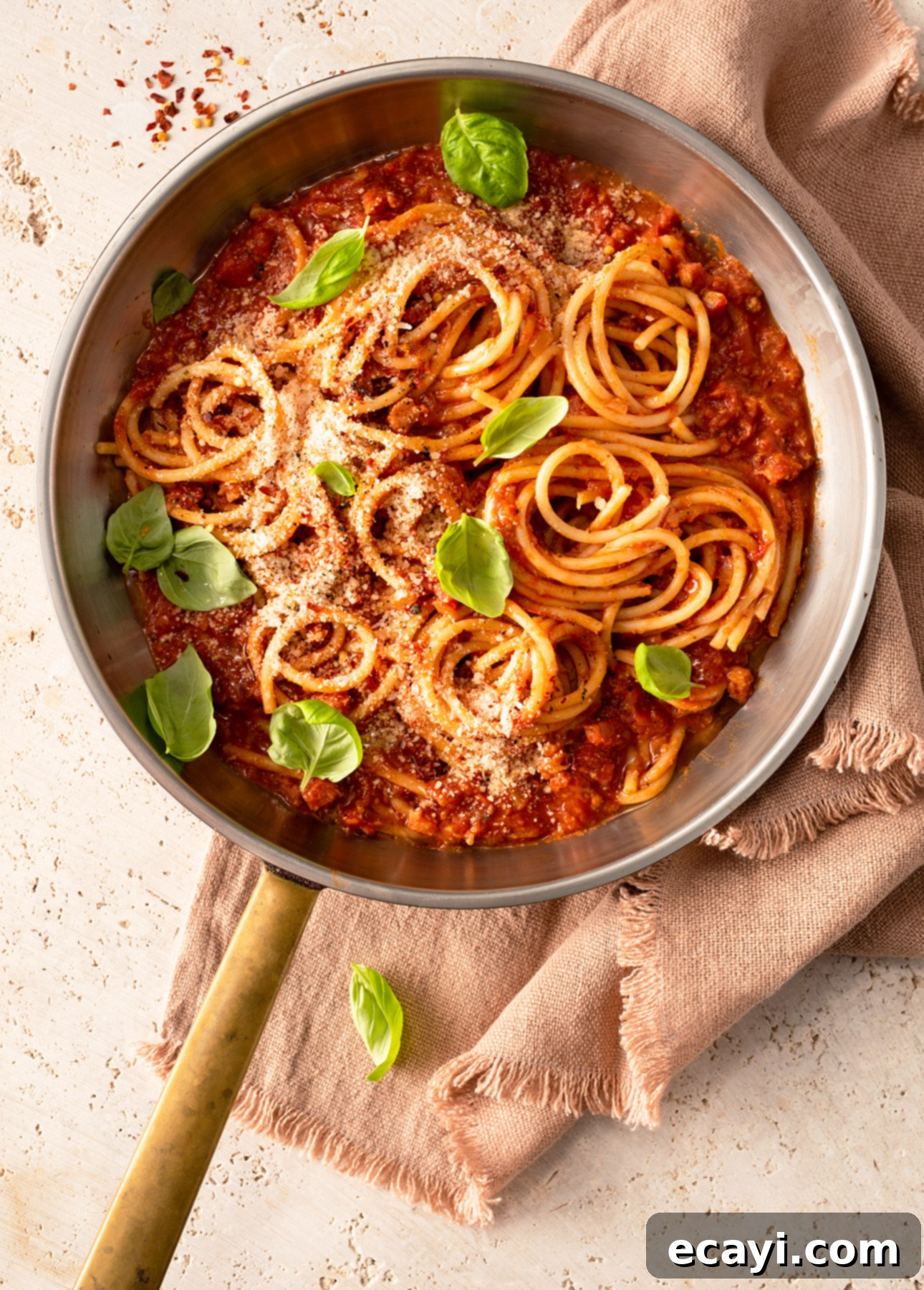Authentic Bucatini All’Amatriciana: A Roman Classic Made Easy
Experience the rich, bold flavors of Rome with Bucatini All’Amatriciana, a timeless Italian pasta dish. Crafted with just a handful of quality ingredients and ready in under 30 minutes, this classic recipe promises to captivate your palate from the very first bite. It’s an effortless culinary masterpiece that will quickly become a favorite in your kitchen!
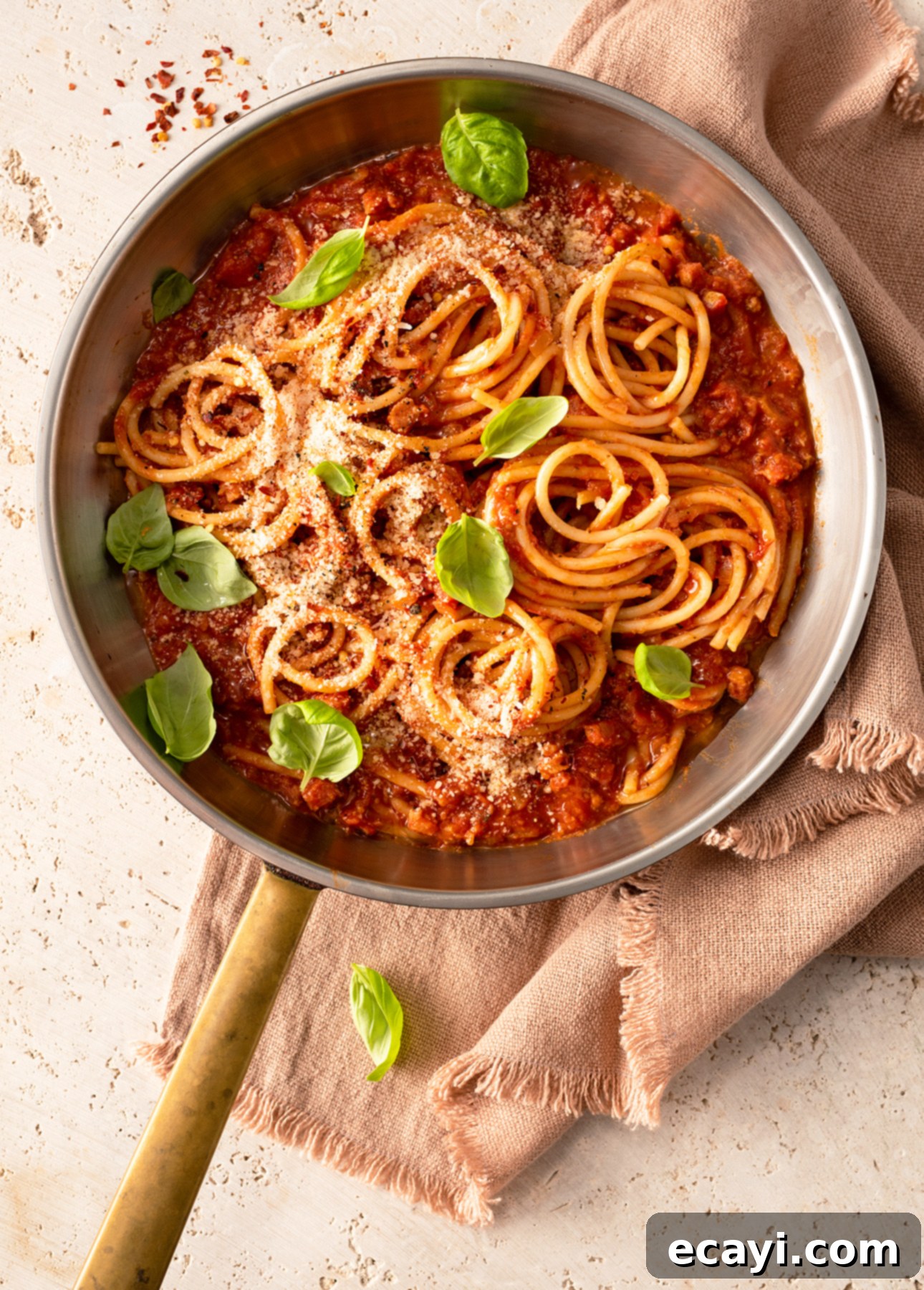
This post contains affiliate links. Full disclosure is at the bottom of the article.
Bucatini All’Amatriciana stands proudly among Italy’s most cherished pasta dishes. What makes it truly exceptional is its profound depth of flavor despite a remarkably simple ingredient list and a cooking time of less than 30 minutes. This makes it an ideal choice for a busy weeknight meal, yet it’s so incredibly delicious and impressive that I frequently serve it when entertaining guests. A dish that consistently earns rave reviews from diners, all while being effortlessly prepared? That’s truly a culinary triumph in my book!
The Roman Roots of Amatriciana Sauce
The illustrious Amatriciana sauce draws its name from Amatrice, a charming town nestled in the Lazio region, deep within the heart of Italy. It is unequivocally one of the most celebrated Roman and indeed, Italian sauces, so much so that it has been formally recognized by the Italian government as a prodotto agroalimentare tradizionale, or a traditional Italian food product. This designation underscores its historical significance and cultural importance in Italian gastronomy.
Traditionally, Amatriciana sauce finds its perfect companion in bucatini pasta. Bucatini is a distinctively thick, spaghetti-like pasta characterized by a unique hole running through its center. While some might find bucatini a bit challenging to eat – its thickness can be tricky to twirl, and the occasional splash of sauce is part of its playful charm – its hearty texture and satisfying shape are precisely why it pairs so beautifully with the robust Amatriciana sauce. The central hole also allows the rich sauce to seep inside, ensuring every bite is bursting with flavor. It might not be the most demure choice for a first date, but it certainly makes for an engaging and thoroughly enjoyable dining experience.
The philosophy behind authentic Bucatini All’Amatriciana, like many revered Italian recipes, revolves around simplicity and quality. It calls for only a few key ingredients, but crucially, the excellence of these products directly determines the sublime taste of the final dish. Compromising on quality here means compromising on authenticity and flavor.
The Unsung Hero: Guanciale
At the very heart of Amatriciana sauce lies guanciale. This essential ingredient is a cured pork product, much like pancetta, but it originates from a different part of the pig: the jowls or cheeks. Unlike pancetta, which comes from the belly, guanciale boasts a higher fat content and a more intensely savory, concentrated flavor. Despite its richness, it possesses a remarkably fine and delicate texture that truly melts into the sauce. The rendered fat from the guanciale provides an unparalleled foundation, infusing the sauce with a silken richness and depth that simply cannot be replicated by other ingredients. My own love affair with Amatriciana began with the authentic taste of guanciale, a true testament to its irreplaceable role in this classic dish.
Slices of Italian guanciale, the cured pork product traditionally used to make Bucatini All’Amatriciana pasta. Its distinct flavor is foundational to authentic Amatriciana.
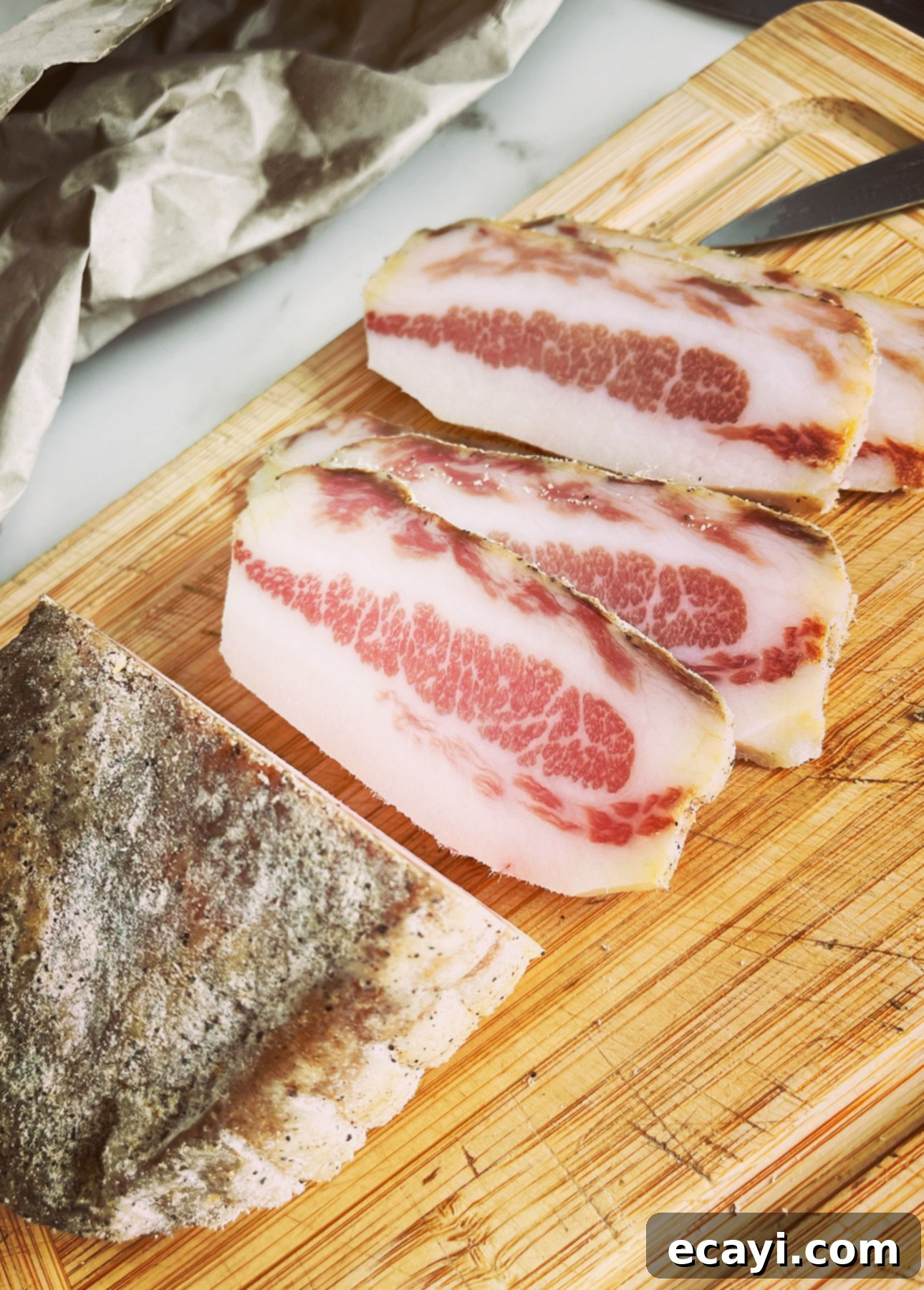
The Great Debates: Onion and Spice
It’s fascinating how some ingredients in traditional Italian sauces can spark lively debates among cooks and regions. My dear Italian friend Eleonora, a true connoisseur who graciously shared the foundational insights for this recipe, once told me that merely asking an Italian whether they use onion in their Amatriciana sauce is enough to ignite a passionate discussion! Following her advice, I wholeheartedly include a small, minced onion, appreciating the subtle yet crucial layer of sweetness and aromatic complexity it contributes to the sauce. This minor addition, while debated, enriches the overall flavor profile without overpowering the star ingredients.
Similarly, the choice of spice can be a point of personal preference. I often add a modest pinch of crushed red pepper flakes to introduce a delightful hint of warmth and “punch” to the dish. However, for those who prefer a milder heat or a different aromatic note, a generous grind of freshly cracked black pepper makes an equally excellent addition, providing a gentle peppery finish without the chili kick.
The Non-Negotiable Cheese: Pecorino Romano
When it comes to the cheese in Amatriciana sauce, there is absolutely no room for compromise: it must be Pecorino Romano. Pecorino Romano cheese possesses a singularly unique, sharp, and salty flavor profile that is absolutely essential for seasoning and perfectly balancing the sauce. It imparts a distinctive tang and savory depth that rounds out the flavors in a way no other cheese can. For the most authentic and exquisite taste, always opt for a block of genuine Pecorino Romano and grate it fresh. Using a Microplane or the finest side of a box grater ensures a delicate texture that melts beautifully into the hot pasta, creating that coveted creamy emulsion.
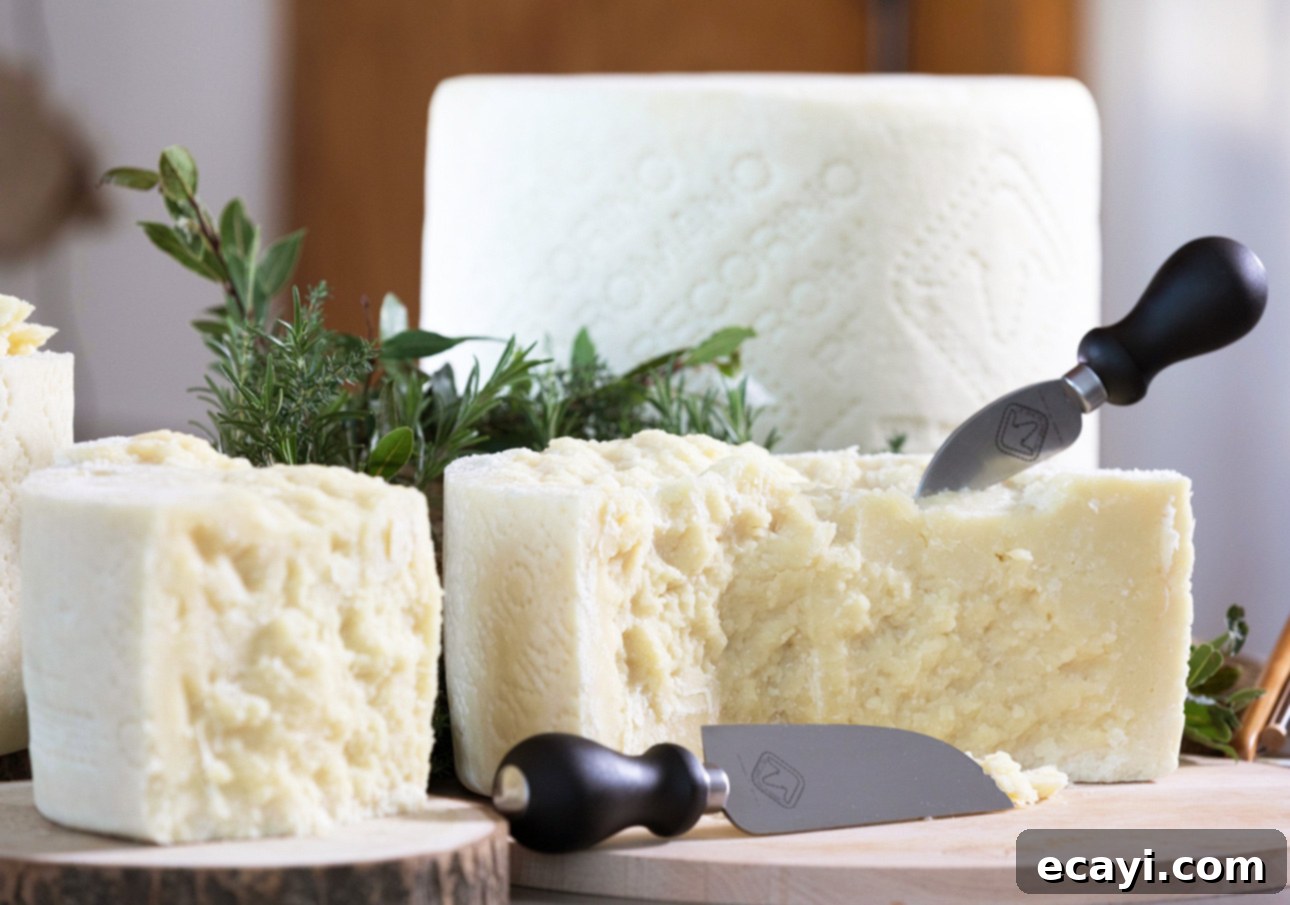
Finally, a generous quantity of high-quality olive oil is crucial. Be sure to use a top-tier, fruity variety of extra-virgin olive oil, especially for the final drizzle. This not only adds richness but also enhances the aromatic notes and provides a beautiful sheen to the finished dish.
Much like its equally famous cousin, Cacio e Pepe, Bucatini All’Amatriciana is a truly memorable Italian dish that absolutely deserves a prime spot in your culinary repertoire. Master this recipe a few times, and you’ll undoubtedly earn a reputation for serving exceptional Italian fare. And the best part? You don’t ever need to reveal just how incredibly simple it is to prepare!
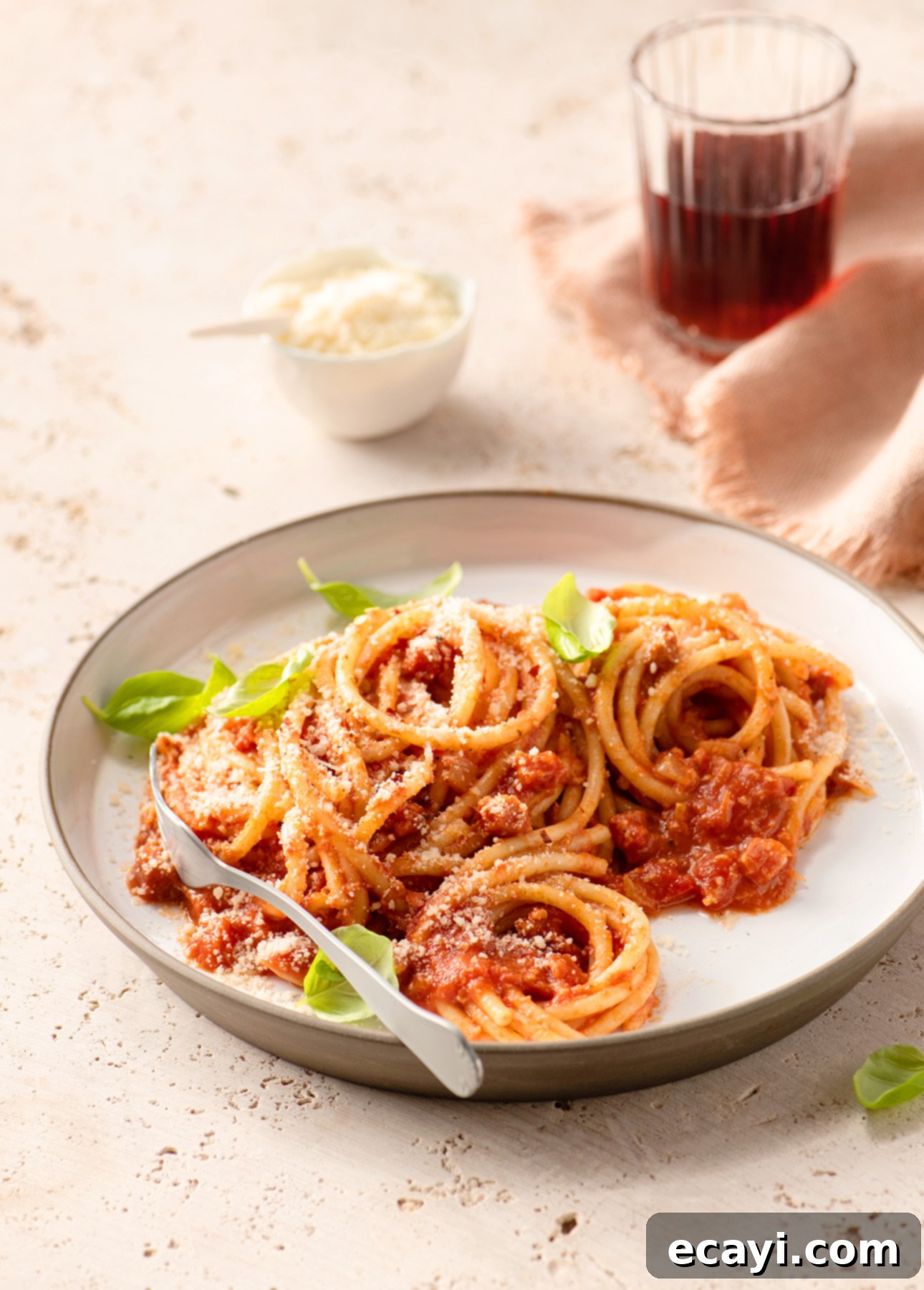
Frequently Asked Questions About Amatriciana
Can Amatriciana sauce be served with any other type of pasta?
While a traditional Italian nonna might raise an eyebrow, you absolutely have my blessing to experiment! If you can’t find bucatini pasta, don’t despair. The most suitable and easiest swap is a thick spaghetti, ideally one with a suggested cooking time of 11 to 13 minutes, indicating its substantial texture. Long pasta shapes generally work best for Amatriciana sauce, as their surface area effectively catches and clings to the rich, flavorful sauce. Other excellent choices for long pasta include perciatelli (similar to bucatini but slightly thinner) or even tonnarelli. If rigatoni or penne are what you have on hand, I won’t judge, but prepare for a slightly different experience where the sauce might not adhere quite as perfectly. Ultimately, a good quality, firm pasta cooked al dente is key, regardless of its shape.
Dry bucatini pasta, ready for cooking. Its hollow center is ideal for capturing rich sauces like Amatriciana.

Are there acceptable substitutes for guanciale in Amatriciana sauce?
Guanciale, as mentioned, is cured pork jowl (or cheek). It’s prepared by rubbing pork jowl with a mixture of salt and various spices, then allowing it to cure for several weeks. This meticulous process results in a remarkably fatty and intensely flavorful cured pork product that imparts a profound depth of savory character to classic Italian pasta dishes like Carbonara or Amatriciana.
Given its specialized nature, guanciale can sometimes be challenging to locate. Your best bet is to inquire at gourmet grocery stores, specialty butcher shops, or authentic Italian delis. However, if guanciale proves elusive, don’t fret – you can still create a delicious Bucatini All’Amatriciana. Pancetta, a more widely available cured pork product, is the most suitable substitute. Made from pork belly, pancetta bears a resemblance to bacon, but crucially, it is never smoked. This distinction is vital, as smoked bacon would introduce an entirely different flavor profile, detracting from the authentic taste of Amatriciana. Pancetta is often sold thinly sliced, but for this sauce, you’ll want to find it cubed or request your charcuterie counter to slice it about 1/3 inch (1 cm) thick. You can then dice these thicker slices into small pieces, perfect for rendering and forming the aromatic base of your sauce. The goal is to mimic the fatty, savory foundation that guanciale provides.
Can Amatriciana sauce be made ahead of time?
Absolutely! Amatriciana sauce is excellent for meal prepping and can be made ahead of time. To do so, prepare the sauce as directed, simmering it until it’s thick and rich, right up to the point where you would typically add the cooked pasta. Once cooked, remove the sauce from the heat and allow it to cool completely to room temperature. Then, transfer it to an airtight container and store it in the refrigerator for up to 4 days. When you’re ready to serve, gently reheat the sauce in a large skillet or sauté pan over low to medium heat while your pasta is cooking. The key to perfection is always cooking the bucatini fresh, right before serving, to ensure it’s perfectly al dente. Transfer the freshly cooked pasta directly into the warm sauce, toss to combine, and then finish the dish with the Pecorino Romano and a final drizzle of olive oil as indicated in the recipe. This method ensures that the pasta absorbs the sauce beautifully, resulting in a dish that is both convenient and incredibly flavorful.
So I can’t use Parmigiano Reggiano in Amatriciana sauce? Really?
Indeed! While both are iconic Italian cheeses, Parmigiano Reggiano is distinctly different from Pecorino Romano, and choosing the right one is paramount for authentic Amatriciana. Different hard Italian cheeses each possess their own unique personality and tend to truly shine when paired with dishes from their specific regions of origin. Bucatini All’Amatriciana originates from Amatrice, a town in the Lazio province, which is also a renowned region for producing Pecorino Romano cheese. Parmigiano Reggiano, conversely, hails from an entirely different Italian region (Emilia-Romagna) and is made from cow’s milk, whereas Pecorino is exclusively made from sheep’s milk.
These differences extend beyond geography and milk type to their fundamental flavor profiles. Pecorino Romano is characterized by its sharp, piquant, distinctly peppery, and intensely salty taste. This bold flavor is crucial for cutting through the richness of the guanciale and tomatoes, providing a vital counterpoint that completes the Amatriciana experience. Parmigiano Reggiano, while undeniably delicious, offers a richer, nuttier, and smoother flavor that, while wonderful in many other pasta dishes, simply won’t impart the same characteristic punch and tang that defines authentic Amatriciana. In essence, Pecorino Romano is a unique product largely responsible for Amatriciana sauce’s unique and unmistakable flavor. If you opt for any other cheese, the resulting dish might still be very good, but it will not genuinely be authentic Bucatini All’Amatriciana. Adhering to this tradition is part of embracing the true culinary heritage of Rome.
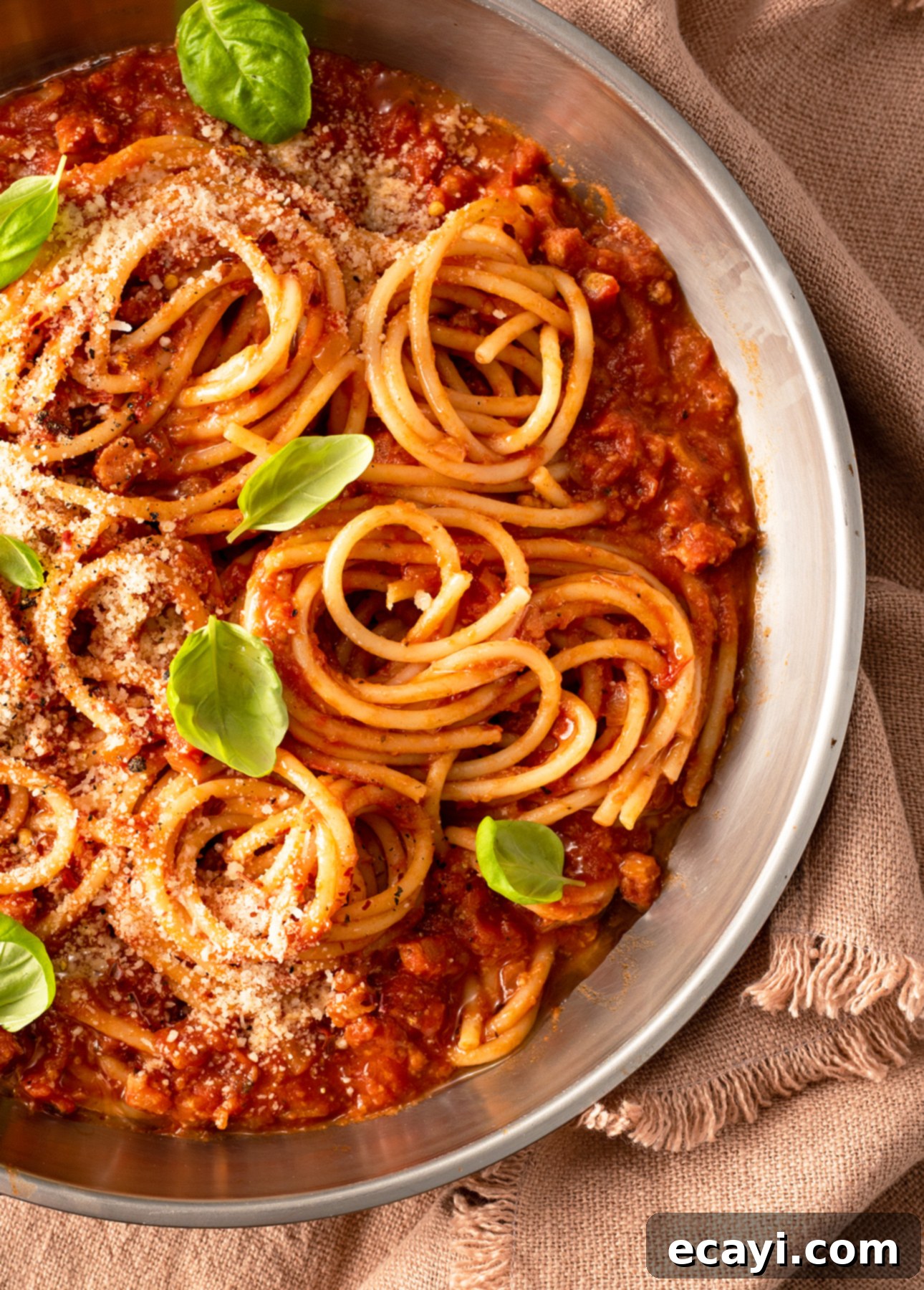
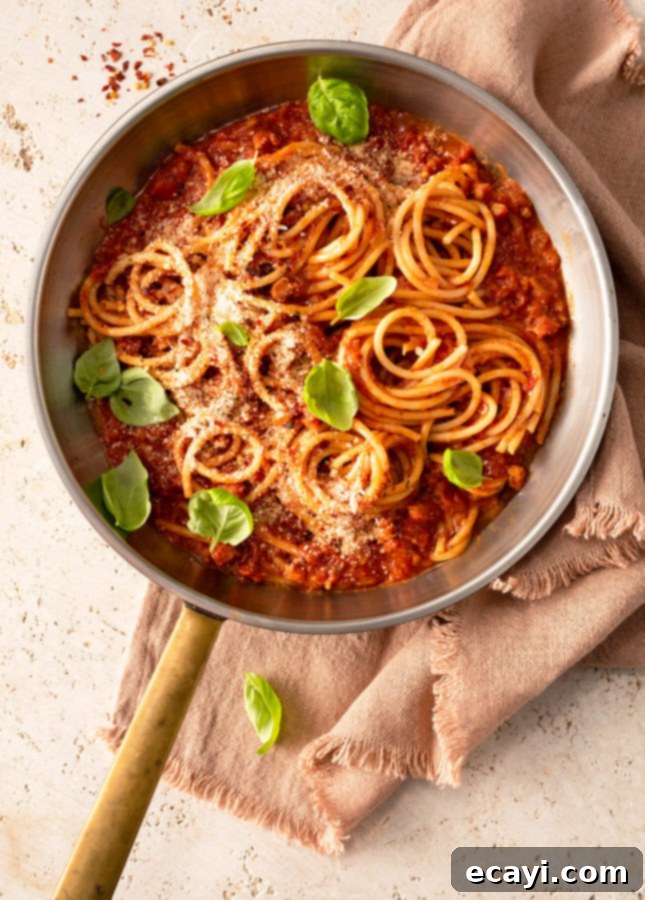
Pin Recipe
Bucatini All’Amatriciana
Ingredients
- ¼ cup extra-virgin olive oil, divided
- 7 oz diced guanciale or pancetta (about 1 cup)
- 1 small onion, minced
- ½ tsp crushed red pepper flakes
- ½ cup dry white wine, such as Pinot Grigio
- 14 oz crushed tomatoes (a small can, or half a large can)
- 6 oz grated Pecorino-Romano cheese (about 1 ½ cups)
- 1.1 lb dry bucatini pasta, or substitute spaghetti
Instructions
-
In a large sauté pan set over medium heat, warm 2 tbsp (30 ml) of the olive oil. Add the diced guanciale or pancetta and fry until golden and wonderfully crisp. A significant amount of flavorful fat will render into the pan; this is desirable as it forms the rich base and gives the sauce its silky texture. Introduce the minced onion and crushed red pepper flakes to the pan, stirring until the onion becomes translucent. Pour in the dry white wine and bring it to a vigorous boil, allowing it to reduce completely until almost evaporated. Stir in the crushed tomatoes and continue to cook, uncovered, for about 10 minutes, or until the sauce has thickened beautifully. Season the sauce lightly with a pinch of sea salt, remembering that the Pecorino cheese will add further saltiness later. Reduce the heat to its minimum to keep the sauce warm while the pasta cooks.
-
If you’re preparing the Amatriciana sauce in advance, this is the perfect moment to take it off the heat and let it cool thoroughly to room temperature. Once cooled, transfer the sauce to an airtight container and store it in the refrigerator for up to 4 days.
-
While the Amatriciana sauce is simmering (or reheating), bring a large pot of water to a rolling boil. Generously salt the water before adding the bucatini pasta. Set a timer for 1 minute less than the cooking time recommended by the pasta manufacturer. During the first few minutes of cooking, use tongs to gently stir and move the pasta around to prevent the bucatini strands from clumping together. Just before the pasta is fully ready (al dente), scoop out and reserve approximately 1/2 cup (125 ml) of the starchy pasta cooking water. This liquid is essential for achieving the perfect sauce consistency.
-
Drain the bucatini pasta thoroughly, then immediately transfer it into the sauté pan containing the Amatriciana sauce. Ensure the sauce is still set over low heat. (If you prepared the Amatriciana sauce ahead of time, make sure it’s gently reheated before this step.) Add the freshly grated Pecorino cheese, the remaining extra-virgin olive oil (2 tbsp/30 ml), and the reserved pasta cooking water to the pan. Using a spatula or tongs, vigorously stir and toss the pasta until the Pecorino cheese melts and emulsifies with the sauce, coating every strand beautifully.
-
Serve your Bucatini All’Amatriciana piping hot, optionally garnished with an extra sprinkle of finely grated Pecorino cheese for an added flourish of authentic flavor.
Did you make this?
Tell me how you liked it! Leave a comment or take a picture and tag it with @foodnouveau on Instagram.
This site participates in the Amazon Associates Program, an affiliate advertising program designed to provide a means for the site to earn fees by linking to Amazon and affiliated sites.
If you click on an affiliate link, I may earn advertising or referral fees if you make a purchase through such links, at no extra cost to you. This helps me create new content for the blog–so thank you! Learn more about advertising on this site by reading my Disclosure Policy.
